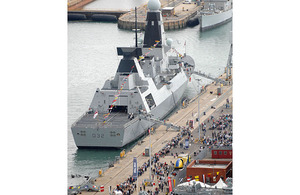Royal Navy's most advanced destroyer sets course into service
While appearing at Portsmouth Navy Days the first of the Royal Navy's new Type 45 Class destroyers, HMS Daring, was declared formally available for tasking on Saturday 31 July 2010.

Royal Navy Type 45 destroyer HMS Daring at HM Naval Base Portmouth during the Senior Service's Navy Days annual open event [Picture: Leading Airman (Photographer) Dean Nixon, Crown Copyright/MOD 2010]
HMS Daring was commissioned into the Royal Navy fleet in July 2009. Since then the ship has been undertaking a series of MOD-managed trials and acceptance activities to test and confirm the ship’s technical capability and ensure that it is ready to join the Royal Navy as a front line warship.
This period has included Daring’s crew undertaking rigorous basic operational sea training and the Type 45 making its first overseas visit, to Ireland.
Now, the 7,500-tonne ship can officially begin to play a key role in various operations around the world.
HMS Daring’s ability to operate a range of helicopters from its flight deck and embark up to 60 troops, in addition to the ship’s own company, make the warship a versatile Royal Naval asset, able to support land forces and carry out humanitarian missions.
Minister for Defence Equipment, Support and Technology, Peter Luff, said:
The first in-service date for the Type 45 Class is a significant achievement for both the programme and the Royal Navy. It represents the first step towards delivering the fleet of the future.
Along with her five sister ships, Daring will set new standards in air defence and will demonstrate her wider ability across the future challenges faced by the Armed Forces. I have no doubt that Daring will provide sterling service throughout its life.
Captain Paddy McAlpine, Daring’s Commanding Officer, said:
Daring represents a step change for the Royal Navy. Her technology and design make her an easy ship to fight with and my ability to control the airspace around the task force is unsurpassed.
My ship’s company and I are proud and privileged to serve in this truly magnificent ship, forging the way for the class. The potential that I have witnessed to date promises that this capability is set to become the cornerstone of the future Royal Navy.
Head of the Type 45 programme, Commodore Steve Brunton, said:
This milestone is the culmination of a huge amount of hard work over five years of construction, and another two years of trials and development, by 4,000 workers at the Clyde and Portsmouth shipyards, many more at suppliers across the UK, and staff at MOD and in the Royal Navy.
The strong relationship between MOD, industry and the Royal Navy has been critical to achieving today’s success.
HMS Daring was in Portsmouth at the weekend as part of Navy Days, the Royal Navy’s annual event that gives the public the chance to meet the people and the ships of the modern Navy.
More than 25,000 visitors flocked to Portsmouth Naval Base for the three-day event which ended on Sunday 1 August.
HMS Daring and sister vessel Dauntless opened their doors to the public along with six other ships, including ‘floating hospital’ Royal Fleet Auxiliary vessel Argus, fresh from a recent refit.
Historic ships HMS Victory and HMS Warrior also proved a big draw, as did a BAE Systems exhibition featuring the company’s current shipbuilding projects, including the two Queen Elizabeth Class aircraft carriers, and a glimpse of the future, the Type 26 combat ship, which is expected to enter service in the early 2020s and will replace the Navy’s current fleet of Type 22 and 23 frigates.
Commodore Rob Thompson, Naval Base Commander, said:
Navy Days was a huge success. The mainly dry and warm weather played a part but a big draw was seeing the Royal Navy’s ships and personnel at close hand.
The event proved an exciting opportunity to show the general public the wide role of the Royal Navy and what its men and women are up to across the globe - from taking the fight to the Taliban in Afghanistan to countering pirates in the Gulf of Aden.
HMS Daring is due to undergo further operational training and capability development in preparation for her first operational deployment, planned for 2011.